1. Name of the location of 90% of epistaxis
2. A genetic disorder that forms AV malformations in the skin, lungs, brain etc
3. Name of posterior vascular plexus in the nasal cavity causing posterior epistaxis
4. 1st line treatment for all epistaxis
5. The common brand name for anterior nasal packing
6. Chemical used in cautery sticks
7. Physically scaring complication of posterior nasal packing with foleys catheter
Coming soon..
Sore Throat
Introduction.
Clinicians who work in primary care will often see patients complaining of a sore throat. The severity of the throat pain varies from very mild but annoying to very severe and life threatening so it is important for the clinician to be able to make a diagnosis and offer treatment to the patient or to make an urgent referral to hospital.
This tutorial will look at three common causes of a sore throat and a rarer one. The diseases are pharyngitis, tonsillitis, chronic pharyngitis and cancer. Between them, they make up almost all of the causes that you will see in primary care. There are many other causes of a sore throat but it is important to understand these causes first.
When taking a history patients may say they have pain in their throat when in fact the pain is in their mouth or in the neck so be careful when you take your history. This tutorial is only about throat pain.
The tutorial starts with a little anatomy and physiology and then goes on to look at the individual diseases themselves. It ends with some suggestions on management of patients with sore throat and a short quiz.
Anatomy and Physiology
The throat is a term that we use to describe the pharynx. The pharynx is a muscular tube that runs in the midline from the base of the skull above to the oesophagus below. It has three areas: the nasopharynx at the top, the oropharynx in the middle and the laryngopharynx at the bottom.
The tube has a number of big holes in it and all of these are on its anterior side. The uppermost hole is in the nasopharynx and this is where the back of the nose joins the pharynx.
In the oropharynx there is another big hole and this is where the mouth joins the pharynx. Finally, in the laryngopharynx there is the third big hole, which is where the larynx joins the pharynx.
Have a look at these images to understand this better.
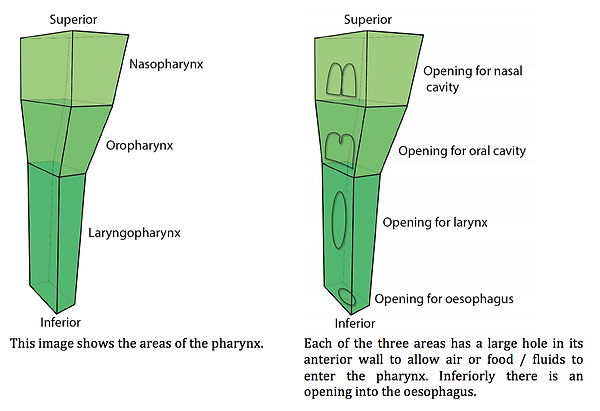
The pharynx has a number of smaller holes in it for nerves, blood vessels and ligaments but these are not important for this tutorial.
In the next image the nose (blue), oral cavity (purple) and larynx (orange) have been added together with the tongue, tonsil and some muscles.
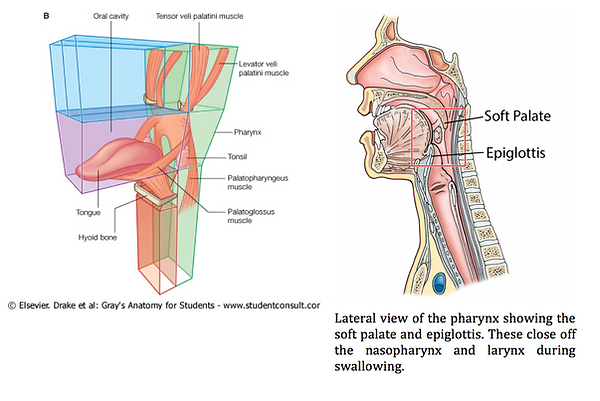
The purpose of the pharynx is to provide a way of getting food and fluid into the oesophagus during swallowing but it also has to allow air into and out of the lungs for breathing.
When we swallow, the tongue pushes our food into the oropharynx and this triggers an automatic sequence during which the muscles of the pharynx squeeze food downwards into the oesophagus. So that food does not go up into the nose during the swallow the nasopharynx is closed off by the soft palate. The epiglottis closes off the larynx so that food does not go into the lungs.
The picture below shows the palate being closed and the epiglottis covering the larynx during swallowing.

Bolus is the name for the chewed food. In picture A it is inside the oral cavity and is being pushed backwards towards the oropharynx. In B the soft palate has lifted to close off the nasopharynx as the bolus moves into the oropharynx. In C the epiglottis is closed over the larynx and the bolus has entered the laryngopharynx. In D the bolus is in the oesophagus.
There are some diseases that stop the soft palate moving up to close the nasopharynx. Motor neurone disease, tumours in the nasopharynx and cleft palate are just some of these. When the patient swallows, food or fluid pass up into the nose and may come out of the nostrils.
Likewise, there are diseases that stop the epiglottis from closing over the larynx during swallowing. Motor neurone disease, cerebrovascular accidents (stroke) and pharyngeal tumours are just a few of these. When the patient swallows, food or fluids fall into the larynx and then down into the lungs. This causes violent coughing during the swallow and gives the patient severe chest infection.
During breathing the nasopharynx and larynx are open.
Anatomy of the Neck
You should know a little about the anatomy of the neck because an examination of the mouth and pharynx is not complete without an examination of the neck to look for lymph nodes.
Lymph nodes are small swellings in the lymphatic system and are responsible for filtering tissue fluids and defending against infection and cancer. In healthy people they can be difficult to feel unless they are enlarged by disease. If your patient is very thin, however, you may be able to feels them quite clearly. Children often have lymph nodes in their necks because they get a lot of infections.
The next picture shows where the lymph nodes are in the neck. These are the areas you must examine to see if they are painful, red or swollen. You examine by first looking at the neck and then feeling the neck but I shall not go into details of the exact technique here.
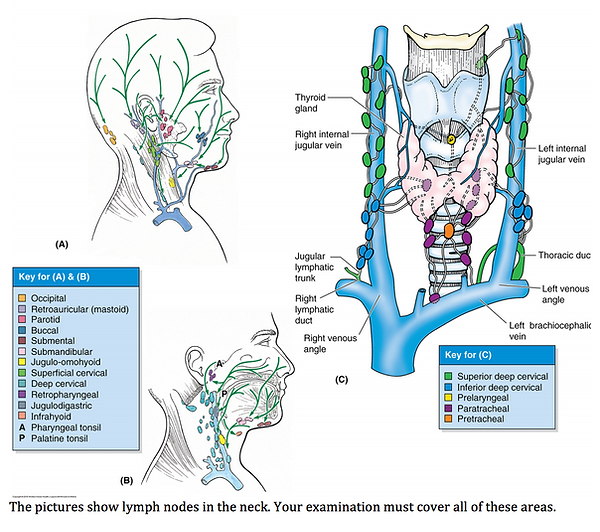
Clinical Anatomy
Your ability to examine the pharynx is limited because a lot of it requires mirrors or flexible telescopes for proper assessment. However, you are able to see some of it and this together with a good history and neck examination should give you the correct diagnosis much of the time.
Below, there is a picture of the oral cavity and oropharynx as seen through the mouth. All of these areas are easy to see and need a careful examination. Note that the term palatine tonsil is used. You will find this in some texts while others call it the tonsil or oropharyngeal tonsil. It’s all the same thing.
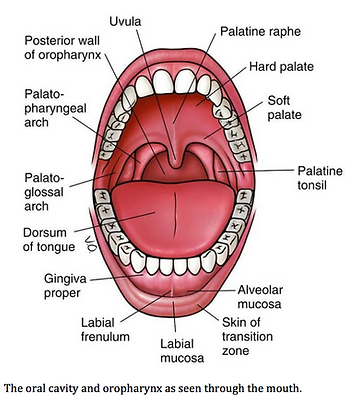
You should examine normal people for a while so that you can build a picture of what the oral cavity and oropharynx should look like and what a normal neck feels like.
Diseases
There are very many diseases in the pharynx and a lot of them cause a sore throat but I only want to concentrate on four causes. I have chosen them because they are common or very serious. The diseases are: pharyngitis, tonsillitis, chronic pharyngitis and cancer.
Pharyngitis – acute and chronic.
Acute pharyngitis is simply a mild viral infection of the pharynx. It is the commonest cause of a sore throat and usually only lasts for a few days. During this time there will be some discomfort on swallowing and there may be some tenderness overlying the nodes high in the neck (jugulodigastric nodes). The lining of the pharynx may look a little red.
It often happens at the same time as a common cold or laryngitis so the patient may have symptoms of hoarseness, blocked and runny nose, sneezing and itching of the nose. All of these symptoms will settle down quickly and the patient will return to normal.
The only treatments that are needed are rest, plenty of fluids and a mild painkiller like paracetamol or ibuprofen.
Chronic pharyngitis refers to the situation where there is a sore throat for more than six weeks. This is caused by a number of different things including: indigestion (acid reflux disease), inhalation of tobacco smoke or environmental smoke at work or home, toxic chemicals, inhaled drugs for asthma, alcohol and very spicy foods. Infection in the tonsil and nose can also cause it.
When you examine someone with chronic pharyngitis you will often find that the neck is normal and that the throat is red with little swellings on the posterior oropharyngeal wall. These lumps are inflamed lymphoid tissue in small islands called follicles.
Chronic pharyngitis is a hard thing to treat, as it tends to come back when treatment has finished. The main problem that you face in AEC, though, is that you will not be able to easily distinguish the pain of chronic pharyngitis from the pain of early cancer of the throat because your examination cannot be good enough to do this. I suggest that patients who have chronic throat pain are referred to the local ENT department for further investigation.
Tonsillitis.
Tonsillitis is an infection of the tonsil and it is a much more severe problem than pharyngitis. Patients are very unwell with it and have pain and a high temperature. Sometimes they have difficulty opening their mouths, swallowing and aches and pains elsewhere. They feel generally unwell.
The commonest cause of tonsillitis is viral (for example adenovirus, rhinovirus, Epstein Barr or coronavirus) but bacterial infection (usually streptococcus) is also common.
Treatment of mild or uncomplicated cases is simply to have rest, take plenty of fluids and mild painkillers such as paracetamol or ibuprofen. This is the same that you would suggest in pharyngitis. However, if the symptoms are severe or there is a high temperature, difficulty with mouth opening and swallowing you should prescribe oral antibiotics. If the patient is unable to swallow at all they should be sent to hospital.
Penicillin is a very effective antibiotic but you can use erythromycin if the patient is allergic to penicillin. See the sore throat management pathway for details of doses and durations.
In some patients the infection will become so severe that they cannot speak well and cannot open their mouths fully. These patients need to be in hospital as they may have quinsy (also known as peritonsilar abscess). This is an abscess deep to the tonsil. It pushes the tonsil towards the midline of the throat and also pushes the uvula away.
Below there are pictures of tonsillitis and quinsy.
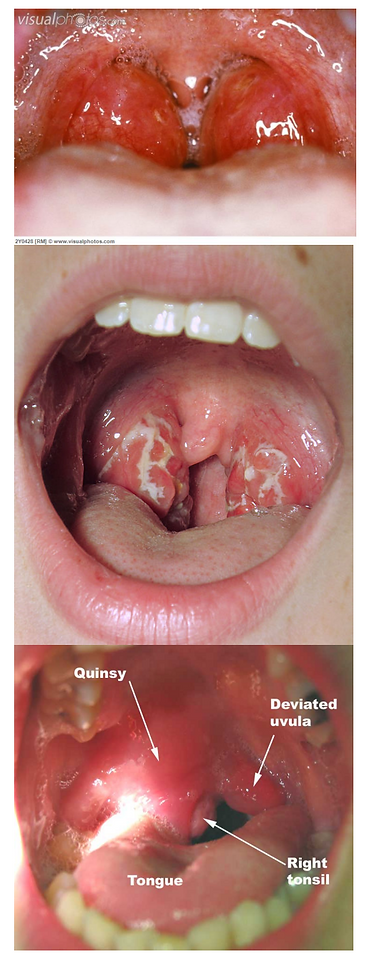
The tonsils are swollen and red. This patient has tonsillitis and the size of the tonsils may make breathing difficult.
This patient has a bacterial tonsillitis. You can see pus on both tonsils. They are also slightly swollen.
In this picture the right tonsil has quinsy. It pushes the tonsil towards the midline and the uvula deviates to the left side.
Quinsy is a severe infection and the pus that it contains must be drained in the hospital.
Cancers.
Many cancers cause throat pain. For example laryngeal cancer, pharyngeal cancer and tongue cancer can all cause pain and so can tonsil cancer. These are very important causes of pain and you must not miss them. It is difficult to see many of these cancers because they are hidden from view. Tonsil and tongue cancer should be fairly easy to see but pharynx and larynx disease is hidden from you. So how do you know if there is a cancer present?
Red Flags
A red flag is a way of showing danger. Red flag symptoms and signs are symptoms that indicate that something dangerous may be happening. In the case of sore throat the red flags mean that there may be a cancer present.
The red flags to think and ask about are as follows:
-
Does the patient smoke? – cancers are far commoner in smokers than in non-smokers
-
Alcohol – does the patient drink a lot of alcohol? If they do they have a higher risk of cancer especially if they smoke as well
-
Hoarseness – Is the patient’s voice hoarse? If so it may be that the patient has a laryngeal cancer
-
Swallowing difficulty – Patients with pharyngeal cancer may have difficulty with swallowing food or fluids
-
Coughing up blood – this may indicate larynx or pharynx tumours.
-
Recent weight loss
-
A lump in the neck that is not tender
-
Pain that radiates to the ear on swallowing – referred otalgia
How do I make a diagnosis?
Throat pain happens in all of the disease that I have listed and in many more. So how do you make a diagnosis when there are so many things to choose from?
It is true that it can be difficult but here are some principles that will help you. Remember that if you are worried about the problem you should refer the patient to their ENT hospital if you can.
If throat pain has come on recently and the patient has a temperature, a red throat and tender neck nodes then the diagnosis is probably infective. This means either tonsillitis or pharyngitis.
If the throat pain has been there for more than four weeks and there are Red Flags then you should consider the problem to be a possible cancer. A lot of the time you will be wrong but that doesn’t matter. Your job is to get the patient to where they belong if you can – in a hospital with an ENT surgeon.

Disclaimer
This site is for educational purposes only and as such does not replace clinical judgement. The site contains high-resolution images, although mobile compatible. For optimum viewing, please switch to a HD ready computer.





